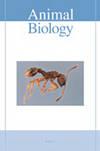Influence of biotic and abiotic factors on adult Odonata (Insecta) in Amazon streams
IF 0.9
4区 生物学
Q2 ZOOLOGY
引用次数: 3
Abstract
Abiotic and biotic factors play an essential role in the structuring of natural communities. Aquatic ecosystems have complex interaction networks, encompassing predator/prey relationships and structural support. Among aquatic organisms, the order Odonata is a model group for understanding those relationships since they can be both predators and prey. Our hypotheses were that Zygoptera are (i) influenced positively by Ephemeroptera, Plecoptera and Trichoptera (EPT) and the Habitat Integrity Index (HII), and negatively by fish and macrophytes; and (ii) Anisoptera are affected positively by EPT and macrophytes, and negatively by fish and HII. We found that Zygoptera were affected by the fish functional trophic groups, while Anisoptera were affected by macrophytes, EPT, fish and HII. Macrophytes affected anisopterans positively because they provide perching sites for adults. The results for EPT and HII may be related since these organisms are also sensitive to environmental changes. More open areas have lower HII values and the negative relationship with Anisoptera may be explained by physiological constraints. The negative relationship between EPT and Anisoptera could be explained by the low occurrence of EPT in open sites, which are the sites that were highly rich in Anisoptera. Finally, the dominance of specific functional trophic groups of fish influences Odonata suborders in different ways. In conclusion, the results show the importance of ecological interactions for Odonata in Amazonian streams in both direct and indirect ways.生物和非生物因素对亚马逊河流域昆虫成虫的影响
非生物因子和生物因子在自然群落结构中起着至关重要的作用。水生生态系统具有复杂的相互作用网络,包括捕食者/猎物关系和结构支持。在水生生物中,蛇目动物是理解这些关系的一个模型群体,因为它们既可以是捕食者,也可以是猎物。我们的假设是:(1)钩翅目受蜉蝣目、翼翅目和毛翅目(EPT)和生境完整性指数(HII)的正向影响,而受鱼类和大型植物的负向影响;(2)异翅目受EPT和大型植物的正向影响,而受鱼类和HII的负向影响。结果表明,钩翅目受鱼类功能营养类群的影响,而异翅目受大型植物、EPT、鱼类和HII的影响。大型植物对异翅目动物有积极影响,因为它们为成虫提供栖息场所。EPT和HII的结果可能相关,因为这些生物对环境变化也很敏感。开放度越高,HII值越低,与异翅目昆虫呈负相关,可能与生理约束有关。EPT与无翅目昆虫呈负相关关系的主要原因是,在无翅目昆虫高度富集的开放地点,EPT的发生率较低。最后,鱼类的特定功能营养群的优势以不同的方式影响河豚亚目。综上所述,研究结果表明,生态相互作用对亚马逊河流域河豚具有直接和间接的重要性。
本文章由计算机程序翻译,如有差异,请以英文原文为准。
求助全文
约1分钟内获得全文
求助全文
来源期刊

Animal Biology
生物-动物学
CiteScore
2.10
自引率
0.00%
发文量
34
审稿时长
3 months
期刊介绍:
Animal Biology publishes high quality papers and focuses on integration of the various disciplines within the broad field of zoology. These disciplines include behaviour, developmental biology, ecology, endocrinology, evolutionary biology, genomics, morphology, neurobiology, physiology, systematics and theoretical biology. Purely descriptive papers will not be considered for publication.
Animal Biology is the official journal of the Royal Dutch Zoological Society since its foundation in 1872. The journal was initially called Archives Néerlandaises de Zoologie, which was changed in 1952 to Netherlands Journal of Zoology, the current name was established in 2003.
 求助内容:
求助内容: 应助结果提醒方式:
应助结果提醒方式:


